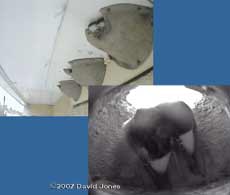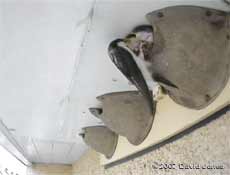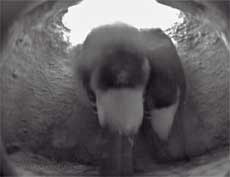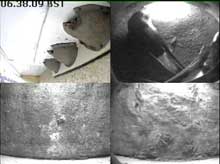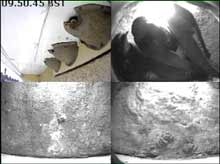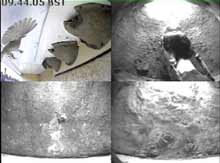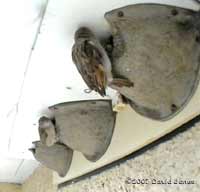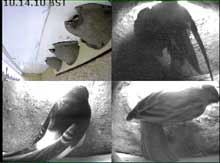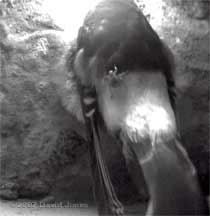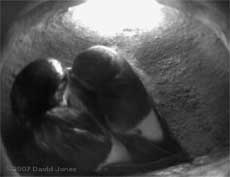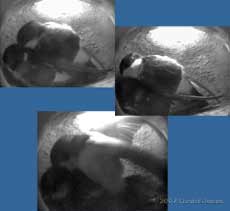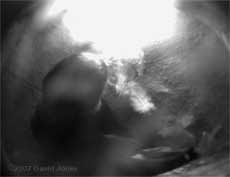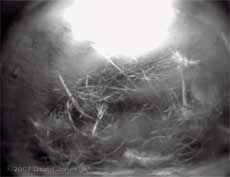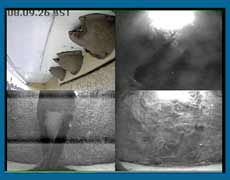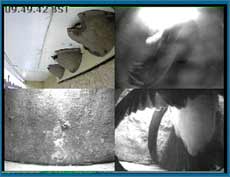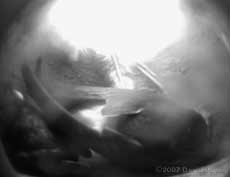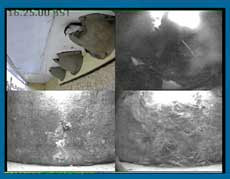Go to the last entry on this page Go to previous entry10 July - One of the disappointing aspects of this Spring was the lack of House Martins in the skies over us, There were a few about, and then usually in the distance, and with the exception of a few brief inspections of the nests on 5/6 June there was no further interest shown in them. Not even a natural nest just a few houses away across the road from us was used, and that has been used regularly for many years. However, there has been a large helping of unexpected brightness at mybitoftheplanet this morning with the unexpected arrival of House Martins at the nests!
To be truthful, these are not Martins that have grown up here, but rather a family that seems to have taken a fancy to the nestboxes as a resting place for their fledglings. Since they first arrived some time after 10am there has been at least one in box 1 - most of the time there are two of them although there were three for a few minutes earlier on,
and they are being fed here by both of their parents.
Look carefully at the back of the left-hand bird in this image and you will see that it is already learning to live with unwelcome passengers, as one of their larger parasites scurries across its back. Not surprisingly, the fledging spends a lot of time dealing with itches!
While I wouldn't expect these youngsters to stay very long, at least I can be sure that the adults are familiar with the nests and that makes me optimistic about the possibility of a late brood - my fingers are well and truly crossed. With that possibility on the cards I will be reinstating the webcam this afternoon, and I will restart the nestbox diaries if nesting does get going. This evening, sometime soon after 8.40pm, an adult joined the two fledglings and it looks at though they have settled down for the night. Finally, a mention of the Swifts. I can confirm that they are definitely nesting in my neighbours' loft, despite all their problems with the Starlings. While I was outside looking at the Martins, two Swifts emerged from the roof space, both swooping low past me, and I have seen them return a couple of times during the day. That may indicate that they have young to feed?
On a couple of occasions I've seen three in nest 1, and once there were four in there.
The Martin activity seems to have attracted the attention of the local House Sparrows. The Sparrows had not shown any interest in these nests during the Spring, but for a short time this morning that changed.
They checked out all three nests - there was a Martin in nest 1 when this Sparrow looked in,
and even entered nests 2 and 3 a couple of times. This webcam image shows a Sparrow in nest 2 while the other nests were occupied by Martins! Since that half-hour period this morning I haven't seen the Sparrows return, and their attention doesn't seem to have put the Martins off.
I've been encouraged by the number of visits I've seen the adults making when there have been no fledglings about, and in this image of nest 1 at least one of the feathers was brought into the nest, rather than being discarded during preening.
This evening there are two birds in nest 1 and one in nest 2 at 8pm, so it looks as though they will be roosting here again tonight. The individual is having to put up with a large parasite ( a better picture this time) which moves over its body extremely quickly every time the bird reacts to the irritation it causes.
At first I thought that the parasite is probably Oeciacus hirundinis, the Martin Bug (an ectoparasite that feeds on the Martin's blood, but can also drink human blood, so cleaning out the nests needs special care!). I found lots of these when I removed the nests to install the cameras. However, Philippe Moniotte (from Belgium) has come to my rescue yet again with the suggestion that is more likely to be a Hippoboscidae fly. These are known as flat flies or louse flies. A Google search has come up with several images that confirm what Philippe tells me.
12 July - A damp start meant that the roosters were slow to leave this morning, and since then I haven't seen so much of the juveniles.
This behaviour that later on would help compact nest bedding, always seems to start before any materials are brought in.
This evening nest 1 has two occupants that had settled down for the night before 8pm, with at least a couple of louse flies happy to take advantage of the situation. There are periods of mutual preening going on between the two birds, although one bird is clearly dominant and occasionally pecks at the other one. It is the bird that keeps itself nearest the entrance most of the time.
Late on during the preening he suddenly mounted his partner, the act of mating taking just a second or so. Later on, mating happened again and since then I've seen the female shuffling several times.
As long as they do not obscure the view completely we could be in for an interesting summer.
This image was captured at just before 10.30am. Despite more attacks on the camera lens, fortunately it is still possible to see what is going on.
I shall have to work on getting around this problem for next year. I used an extra wide-angle lens in this nest to include more of the entrance in the view, and cover more of the width of the nest as compared with the images from nests 2 & 3. However, this has had the drawback of exposing the lens to the great contrast in exterior/interior light levels, with the light from the entrance serving to illuminate and so emphasise the coating that the birds have added to the lens.
16 July - No eggs yet, but a couple of interesting observations to make - First of all, there was no report yesterday as we were taken up with other things, and a (partial) family get-together.
The dark bands on the nest 3 image are due to a problem in the power supply for that camera. Fortunately they disappear as lighting conditions improve.
A bit later in the morning I was surprised to se a fight taking place in nest 2. It lasted a couple of minutes before both birds left. Shortly before the fight started the male had left nest 1 - I wonder if he was involved?
Over the weekend, and having watched their behaviour during the last week, I made the decision to try cleaning the lens on the camera in box 1 during one of their flight periods. The front of the lens is very convex (bulbous) in shape, and its position means that it is the front half of the lens that provided the reflections that bothered the birds. I wanted to leave that part of the lens unclean, while at the same time improving visibility through the rear portion. This would improve the quality of the image in the most important area, where the eggs will be laid, while not causing the reflections to once again cause concern. Early this morning, while the nests were empty, I set up a ladder to the window below the nests, and left it for several hours while the Martins got used to it. That didn't take long and they were soon going in and out as usual. At just before 11am there was no sign of either Martins or Swifts in the skies over us so I headed up the ladder. I used a tool I had made up consisting of a long thin metal handle, at the end of which was attached a narrow block of foam. Wrapped around that were several layers of lens cleaning tissue, moistened with rain water. The job took no more than a couple of seconds, with no need to touch the nest itself.
It's not perfect, but a clean lens would only invite further attacks. The Birds have been in numerous times since that job was done and as far as I can tell they have completely ignored the lens, and hopefully will continue to do so!
I have to update that at 12.50pm - one of the Martins has just had another go at the lens! I shall have to come up with a solution to the problem before next year - perhaps a fine wire grill to protect the lens? It's interesting to see how much time the pair spends in the nest together, often in the same corner, with the male preening his partner, although in this shot he has just turned around to do a shuffle. This is the first time that I can be sure that it is a male doing that. In the case of the Great/Blue Tits and the Starlings there was on ever one bird in the nest when shuffling was carried out, and I always assumed it was the female who was doing it. They were out for a couple of hours this afternoon, reappearing soon after 4pm for a short rest period(?). They took up the exact same positions again. with the female tucked against the back left corner and the male alongside her, preening both himself and his partner, around her head again. Then he turned around to face the other way and shuffled again, in several directions this time, before settling next to the female once more.
After a couple of minutes he was looking out again before leaving, his partner following close behind.
17 July - I think the pair were the only birds in the nests overnight. However, another adult entered nest 3 just before 6am. The male in nest 1 reacted by flying from box 1 to box 3. Immediately after he entered, the third bird left. He stayed in the nest for about ten minutes before returning to his partner who had been preening and doing a few shuffles in his absence. Over the next few hours he preened the female's head, shuffled the nest bedding a few times, and the pair mated at least twice. It wasn't until nearly 10am that the pair left the nest. During the rest of the morning one of the pair (the female, I think) returned to the nest seven times, staying for periods of up to half an hour. After 12.40pm the nest remained empty until they both returned 6pm. The male left again at 6.30pm and at 8.10pm his partner is still alone. Click on the images to see larger versions - |
|
